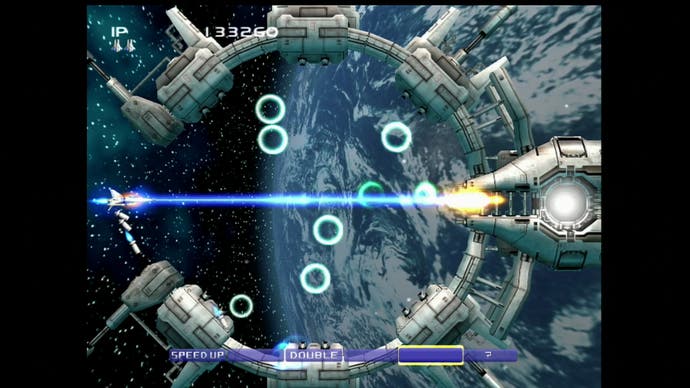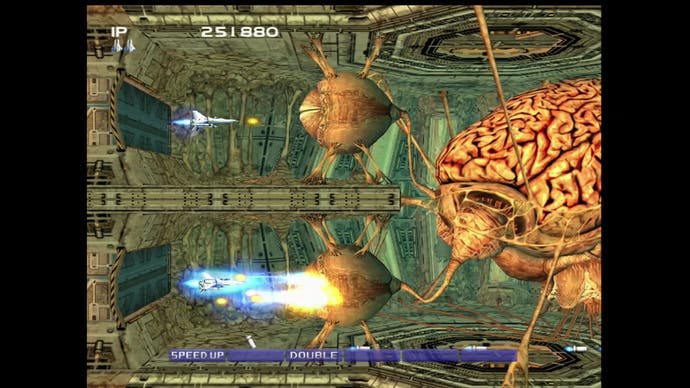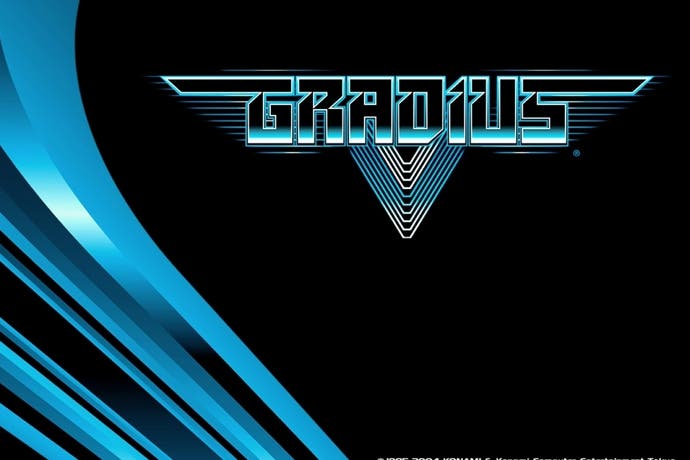Gradius 5 retrospective
Destroy the core.
To understand how it ends, first you must go back to the beginning.
Gradius was born from the 80s post-Space Invaders gold rush, created by a team within Konami's Osaka headquarters headed up by the young and inexperienced programmer Hiroyasu Machiguchi. A failed designer in his early twenties, Machiguchi worked alongside a handful of the company's youthful employees to a simple plan: creating a shooting game that could eclipse the then champion of the genre, Xevious.
Within the naivety of that strategy there was some serious magic at work, though. Building upon the foundations of 1981's Scramble, an early and successful side-scrolling Konami shooter, and utilising the then-sizeable power of a new 16-bit PCB, Machiguchi's team constructed a world richer than any that had gone before it in the genre.
The result was a playable digest of the culture consumed by hungry otaku in 80s Osaka. Inspired by Star Wars and a team visit to see an anime adaptation of E.E. Smith's Lensman books, Gradius was a deep science-fiction fantasy that propelled you through fields of tentacles, across rocky passageways with gurgling volcanoes and running through techno-passages busy with bullet-spewing turrets. Lost in these busy alien landscapes was always the impossibly small, improbably cute Vic Viper. From its inception in 1985, Gradius sold you on the loneliness of space while impressing you with the sheer hostility of it.

Beyond the scrolling stars lay systems informed by RPGs that, thanks to Henk Roger's The Black On and its like, were just beginning to find popularity in Japan. A system whereby player progression branched out at the end of each level was replaced, due to memory limitations, with something more immediate, and something much more effective. Power-up capsules filled a gauge at the bottom of the screen that players could cash in at any point, giving them access to an immaculately balanced toy box of speed-ups, missiles, lasers and shields.
Success wasn't immediate, but Gradius' legacy was lasting, and by the time the task of making its fourth sequel landed at Treasure's Tokyo offices the formula conjured up by a team of first-timers had changed little. Those six slots at the bottom of the screen remain - as does the question mark granting you a shield, a placeholder inserted by an original development team who had run out of time that has remained in place ever since. It's no small testament to the Gradius magic that the rightly revered developer of such genre masterpieces as Ikaruga and Radiant Silvergun decided, some 19 years on, to leave the formula largely intact.
Treasure brought something else though: a little of the sense of purpose missing in the competent if aimless Gradius 4, and a vast, deep love of the series' past. It helped, of course, that Treasure's own history interwove with Gradius', the developer splintering out from Konami in the early 90s. It helped too that lead planner Hiroshi Iuchi's brace of shooters at Treasure carried much of the economy of design and ferocity of challenge classically posed by Konami's series.
All the Gradius hallmarks are there, rendered in the sleek, muscular style of Treasure and co-developer G-Rev's other genre work. The opening level, traditionally a place to noisily grind out upgrades before the real challenge kicks in, is a frantic free-form chase through pendulous Zelos pustules that explode with a deliciously camp whine. The recurring quick-paced scrolling base raid of the series is faster, more aggressive and more spectacular than those it builds upon, the screen a whir of mechanical doors and swirling flak.
There's respect for tradition in Gradius 5, but also a willingness to subvert it. Superficially this is an easier game than its predecessors - Vic Viper's hitbox has been dramatically reduced, while the forgiving revival system from early Gradius spin-off Salamander has been parachuted in, and now it's possible to pick up floating options scattered after losing a ship. Previously in Gradius, hard-earned power-up progress could be wiped out by a single unseen bullet, making it a game where a one-credit run wasn't good enough - to see through to the end, you'd have to try and hold on to a single life. Gradius 5 softens the sharp difficulty curve, but that doesn't mean its claws are blunted.

With a little more weight on the player's side, Treasure restores the balance by crafting levels that pose a superhuman challenge. It's a statement of intent when the second stage climaxes in a gruelling boss rush, and one that's escalated set-piece by set-piece, until, come the seventh stage, the polite trail of enemies that prefaces every level in Gradius history becomes a hellish screen-filling swarm.
Beneath the chaos is the kernel that's made Gradius a great shooter, and one that still stands out from its peers - progression's more often about improvisation than it is memorisation, and in the midst of the curtains of bullets and shifting walls there's always room for a little creative expression. Gradius 5 runs further with its most significant addition to the formula of Machiguchi's team, allowing extended control over the options swinging in Vic Viper's wake. They can be frozen into place, allowing you to throw and hold deadly shapes, or directed to spit blue dashes of laser fire across the screen.
There's still study required for success in Gradius 5, but more than ever it's backed up by allowing for moments of audacious flair - for moments of improbable risk turned into impossible escape by a second's quick thought. Treasure ran the series' system's deeper, but it's never far away from the humble vision of that original team in Osaka: it's about the nerdish dream of being the lone starfighter taking on an entire fleet single-handedly, and about the iconic heroism of escaping the Death Star as it ignites around you.
It's about something simpler, too. The appeal of the shooter is in the direct engagement with a designer's sometimes complex systems, as well as the pursuit of the high score. Fundamentally, though, it's about the simple pleasure of pointing a laser at something and then watching it explode, something at which Gradius 5 excels like no other. Bosses don't just blow up - they expire in noisy, operatic laments that shudder the screen and slow down the fabric of time. Even the cannon fodder exits the stage with bangs that crack with the ferocity of a revolver being let off within inches of your ear.

Hitoshi Sakimoto, a composer used to more pastoral affairs such as Final Fantasy Tactics and Valkyria Chronicles, grounds the fireworks with a score that's both stately and urgent, though it's never somber. Indeed there's none of the solemnity that runs through its contemporary, R-Type Final - a game that foresaw the death of its genre, as well as its developer, and went out in a poetic swell of melancholy. Gradius 5, on the other hand, is at its most serious when in pursuit of pure, visceral joy.
Which in many ways makes it the more sobering game, in hindsight. A relatively high-profile release that brought together the masters of the form with one of the genre's greatest series, Gradius 5 was a big-ticket production - the kind of which shooters had hardly seen before, and will most likely never see again. A Gradius 6 was part of Konami's early plans for the PlayStation 3, though it was later taken off the development schedule - elsewhere, Iuchi moved on from Treasure, his only game since the modest but impressive Kokuga. Treasure, meanwhile, has struggled following Iuchi's departure in 2006, its main work now coming from contracts not quite as alluring as the one Konami threw its way with Gradius 5.
One of Gradius 5's sweetest tricks is in its Ouroboros tale of Vic Viper's victory over the Bacterion. Konami's shooters, like many others in the genre, have always rewarded completion of the game with a new loop where enemies are tougher, and hostile bullets more plentiful. In Treasure's telling, it's excused by a time hole through which you meet your future self in the second stage, going on to take that role come the game's climax.
Unlike other shooters, though, Gradius 5 loops near infinitely, its challenge rising until its thin corridors are impossibly thick with enemy fire (a challenge top-tier players like BGR-44 rise to, with staggering effect). It's a loop destined to repeat again and again, and one Gradius perhaps will never break out of, its legend growing greater with each new player that passes through.

